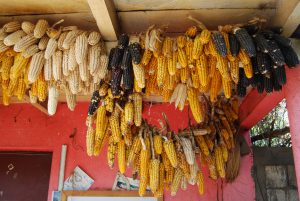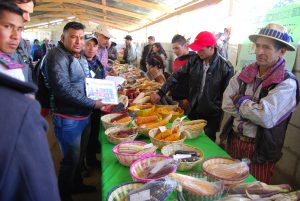
Could marketing native maize contribute to poverty reduction in Guatemala?

Guatemala forms part of the center of origin of maize, and is home to a large amount of the staple crop’s genetic diversity. Smallholder farmers are the guardians of much of this diversity in the form of landraces, native maize varieties passed down through generations that are prized for their flavor and use in traditional dishes. These landraces are gaining interest in the culinary community, and many chefs are willing to pay more for traditional maize varieties. A recent study from scientists working with the International Maize and Wheat Improvement Center (CIMMYT) and the CGIAR Research Program on Maize (MAIZE) investigated whether facilitating the emergence of niche markets for local maize varieties in the western highlands of Guatemala could contribute to poverty reduction.
In the western highlands of Guatemala, over 50% of the population in the region are in poverty, and over 48% suffer from chronic malnutrition. The majority of smallholder farmers grow maize, but also supplement their income with higher-value export crops and off-farm labor. The in-situ, or on-farm, conservation and cultivation of native maize varieties plays a key role in ensuring both local and global food security. Initiatives around the world are working to help farmers benefit from market opportunities for indigenous crops by receiving a price premium for providing the environmental service of conserving agricultural biodiversity. In the study “Maize diversity, market access, and poverty reduction in the western highlands of Guatemala” researchers conducted focus groups, interviews and surveys with farmers working with CIMMYT’s Buena Milpa project to determine whether selling native maize at a higher premium to niche markets could support in-situ conservation and provide higher returns for farmers.
 The study found that the majority of smallholder farmers in western Guatemala had extremely small landholdings, with an average of 0.31 hectares of arable land per farming household. Farmers were often only able to produce enough maize to feed their families for 6.9 months of the year and would have to buy additional maize to eat. As there is such a maize deficit that farmers are unable to meet basic subsistence needs, the researchers suggested that other types of interventions would be more suited for poverty alleviation in the region.
The study found that the majority of smallholder farmers in western Guatemala had extremely small landholdings, with an average of 0.31 hectares of arable land per farming household. Farmers were often only able to produce enough maize to feed their families for 6.9 months of the year and would have to buy additional maize to eat. As there is such a maize deficit that farmers are unable to meet basic subsistence needs, the researchers suggested that other types of interventions would be more suited for poverty alleviation in the region.
“Markets for traditional maize varieties exist in many parts of Mexico, but our results suggest that in Guatemala’s western highlands, the potential links between on-farm conservation of native maize, agricultural markets, and livelihood improvement are unlikely to be realized for most farmers,” the authors said. “In the case of the western highlands, the evidence suggests that the market cannot drive in-situ maize conservation.”
The Buena Milpa project is supported by funding from the U.S. Agency for International Development’s Feed the Future program.
Maize diversity, market access and poverty reduction in the western highlands of Guatemala. 2017. Hellin, J., Cox, R., and López Ridaura, S. In: Mountain Research and Development 37(2):188-197.
